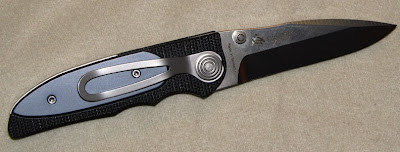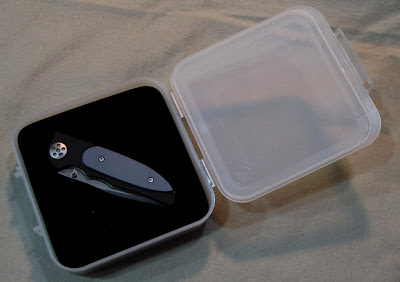In literature, we see cycles through the different knife genre. I remember reading about the drunken pirate/seaman character with his “wicked clasp knife” and watching the Sharks and Jets with their switchblade (automatic) knives. We still talk about the Swiss Army style camp knife and the Rambo-esque survival knife. In the electronic media knife types change weekly.
Even the knives we carry on a daily basic reflect that cycle. Many of us still carry friction folders while others carry only knives that lock open.
So what is a tactical knife? Let’s visit a few sources and find out. (Any mistakes in content are my editing.)
Sgt Don Paul (Everybody’s Knife Bible) served as Green Beret and later described a survival knife as one that helped you survive. It doesn’t take a great jump of imagination to see him describing a tactical knife as one you that assists you in being tactical.
Our electronic fount of modern knowledge, Wikipedia, traces tactical knives to utility knives which were pressed into combat.
“Fighting knives were traditionally designed as special-purpose weapons, intended for personal or hand-to-hand combat. This singularity of purpose originally distinguished the fighting knife from the field knife, fighting utility knife, or in modern usage, the tactical knife.
“Utility knives with stone or flint blades were undoubtedly used in personal combat since Paleolithic times. The first early Bronze Age daggers featured Beaker copper blades, probably done with hand held stone tools.
“In 1984, a Beaker period (ca. 2500 - 2000 BC) copper dagger blade was recovered from the Sillees River near Ross Lough, Northern Ireland, that had a remarkably modern appearance. The flat, triangular-shaped copper blade was 6.75 inches long, 1.65 inches wide, and 0.078 inches in maximum thickness, with beveled edges and a pointed tip, and featured an integral tang that accepted a riveted handle.”
Armed men and women have always need utility knives. The Egyptian Khopesh (shaped like a shepherd’s hook) or Turkish Kilij (a sword with an up-hill bend) wouldn’t serve to trim rope, stab your share of the evening’s meal or cut leather to repair clothing.
If you doubt this try spreading mustard with an American Civil War sword on a hot dog at your next family outing! What is needed is a utility knife that could act as a last resort weapon!
This is reflected in the introduction of Dietmar Pohl’s photo essay “Modern Knives in Combat.”
“Even in the days of modern warfare, knives and bayonets remain indispensible items of equipment for the soldier, whether as tools or edge weapons. …most soldiers also carry a second, usually smaller, knife which meets their needs. Quite often the knives officially issued … are simply unsuitable for everyday task as they were designed as combat knives. … (carry knives are) primary work knives, with which one can open a can or package…”
 |
| The Buck 110 folder, perhaps one of the great camp/hunting utility folders of our time, but missing several of the key features of a tactical knife. |
Wikipedia continues to elaborate: “Folding knives are rarely if ever designed primarily for use as fighting knives or combat knives. However, many armies and military organizations have issued folding "utility" knives that were not intended to be used as weapons, but which had tactical features that appealed to military personnel as well as civilians. Many civilian folding knives also have been privately purchased by both civilians and military personnel for use as general-purpose utility knives.
“The earliest production company to make a tactical knife was Al Mar Knives with their SERE model designed for the military with input from Special Forces Colonel James N. Rowe in 1979.”
It appears the modern tactical knife was born as an field utility knife and had a good publicity agent!
Knife maker Bob Terzuola is credited with coining the phrase "Tactical Folder." In his 2000 publication ”The Tactical Folding Knife,” Bob addresses the question “What is a tactical knife.
Bob first rules out fixed blade knives with the title “The Tactical Folding Knife.” He further states “…(should) be using the term tactical/utility knife because the vast majority of knife owners will never use a knife in combat…”
Addressing combat, Bob goes on to say “the best knife to have in a knife fight is the one you have on you at the moment.”
With this in mind, here’s what Bob considers the defining characteristics of a tactical knife.
- Blade should be approximately 3.5 inches long and both legal and comfortable to carry.
- The knife should be capable of dealing both a penetrating and cutting blow. Both sharpness and blade geometry affect his. The geometry should make the open knife easy to maneuver.
- The knife should be easy to open rapidly and easily, i.e.: Spyderco hole or Terzuola thumb disk (coin opener.)
- The handle should be comfortable and provide some protection to the fingers (from its blade!) while being secure in the hand.
- The knife should be convenient to the user in the carry position and capable of a fast draw.
- The blade should lock open when it is opened and remain open until the user unlocks it.
- The knife should be robust.
Bob doesn’t at this point define steel type or handle material. It seems reasonable that knife with a brass blade or glass handle would have such serious drawbacks nobody would consider it for a utility/tactical knife.








